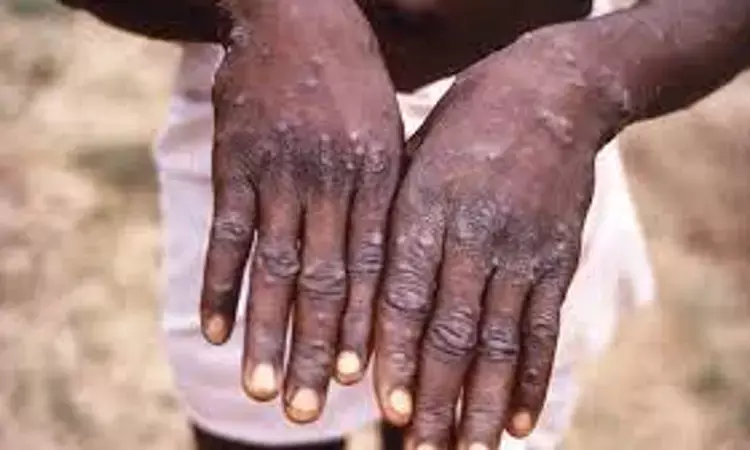- Home
- Medical news & Guidelines
- Anesthesiology
- Cardiology and CTVS
- Critical Care
- Dentistry
- Dermatology
- Diabetes and Endocrinology
- ENT
- Gastroenterology
- Medicine
- Nephrology
- Neurology
- Obstretics-Gynaecology
- Oncology
- Ophthalmology
- Orthopaedics
- Pediatrics-Neonatology
- Psychiatry
- Pulmonology
- Radiology
- Surgery
- Urology
- Laboratory Medicine
- Diet
- Nursing
- Paramedical
- Physiotherapy
- Health news
- Fact Check
- Bone Health Fact Check
- Brain Health Fact Check
- Cancer Related Fact Check
- Child Care Fact Check
- Dental and oral health fact check
- Diabetes and metabolic health fact check
- Diet and Nutrition Fact Check
- Eye and ENT Care Fact Check
- Fitness fact check
- Gut health fact check
- Heart health fact check
- Kidney health fact check
- Medical education fact check
- Men's health fact check
- Respiratory fact check
- Skin and hair care fact check
- Vaccine and Immunization fact check
- Women's health fact check
- AYUSH
- State News
- Andaman and Nicobar Islands
- Andhra Pradesh
- Arunachal Pradesh
- Assam
- Bihar
- Chandigarh
- Chattisgarh
- Dadra and Nagar Haveli
- Daman and Diu
- Delhi
- Goa
- Gujarat
- Haryana
- Himachal Pradesh
- Jammu & Kashmir
- Jharkhand
- Karnataka
- Kerala
- Ladakh
- Lakshadweep
- Madhya Pradesh
- Maharashtra
- Manipur
- Meghalaya
- Mizoram
- Nagaland
- Odisha
- Puducherry
- Punjab
- Rajasthan
- Sikkim
- Tamil Nadu
- Telangana
- Tripura
- Uttar Pradesh
- Uttrakhand
- West Bengal
- Medical Education
- Industry
Dental implications of Monkeypox-premonitory signs appear on oral mucosa as macules and ulcers

Monkeypox appears to be a significant travel-related disease hence dental care workers should note that premonitory signs of the disease usually appear on the oral mucosa as macules and ulcers prior to the characteristic skin lesions suggests a recent study published in the International Dental Journal.
Monkeypox (MPX) caused by the MPX virus, is a contagious disease confined mainly to African regions and is currently making multiple appearances outside of disease-endemic countries. World Health Organization (WHO) very recently declared the current monkeypox outbreak a Public Health Emergency of International Concern. They review here the salient features of Monkeypox and its possible impact on dentistry.
The data on the aetiology, transmission modes, signs and symptoms, diagnosis, and management, including the risk of its occupational transmission in dental settings, were garnered from the current literature, mainly from the World Health Organization and Centers for Disease Control and Prevention databases.
Results:
- Over recent months, Monkeypox has reemerged in more than 88 countries in Europe, North America, and Australia, with some 22000 case reports to date (as of July 2022).
- The initial signs of Monkeypox appear during the prodromal period, in the oral cavity as single or multiple macular lesions on the oral mucosa, accompanied by generalised lymphadenopathy.
- Subsequently, the characteristic rash appears on the skin and spreads centripetally from the trunk towards the palms and soles.
- Monkeypox is a self-limiting disease with very low mortality and may last from 2 to 4 weeks.
- Although Monkeypox is similar to chickenpox, there are a number of differentiating signs, the main element being lymphadenopathy.
- Strict adherence to standard, contact, and droplet infection control precautions, including wearing N95 masks, FFP3 respirators, fluid-resistant attire, and eye protection, is necessary to prevent its spread.
Thus, Monkeypox appears to be a significant travel-related disease. Dental care workers should note that premonitory signs of the disease usually appear on the oral mucosa as macules and ulcers prior to the characteristic skin lesions. Implementing standard, contact, and droplet infection control measures, patient isolation, and referral are important, particularly during a local outbreak. A vaccine specific for Monkeypox is under development, although the smallpox vaccine appears to be effective.
Reference:
Lakshman Samaranayake, Sukumaran Anil, et al. The Monkeypox Outbreak and Implications for Dental Practice. International Dental Journal, Volume 72, Issue 5, 2022, Pages 589-596, ISSN 0020-6539. https://doi.org/10.1016/j.identj.2022.07.006
Dr. Shravani Dali has completed her BDS from Pravara institute of medical sciences, loni. Following which she extensively worked in the healthcare sector for 2+ years. She has been actively involved in writing blogs in field of health and wellness. Currently she is pursuing her Masters of public health-health administration from Tata institute of social sciences. She can be contacted at editorial@medicaldialogues.in.
Dr Kamal Kant Kohli-MBBS, DTCD- a chest specialist with more than 30 years of practice and a flair for writing clinical articles, Dr Kamal Kant Kohli joined Medical Dialogues as a Chief Editor of Medical News. Besides writing articles, as an editor, he proofreads and verifies all the medical content published on Medical Dialogues including those coming from journals, studies,medical conferences,guidelines etc. Email: drkohli@medicaldialogues.in. Contact no. 011-43720751


